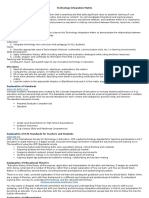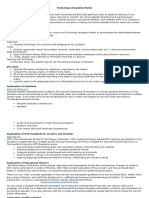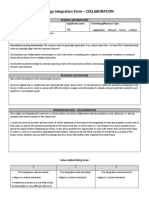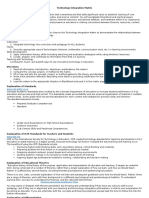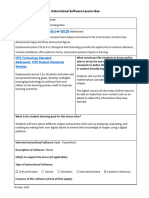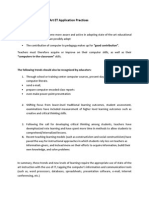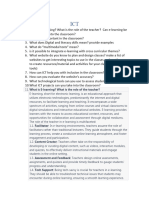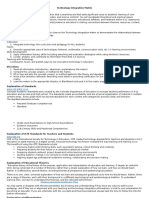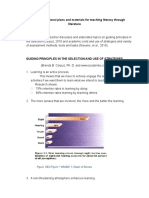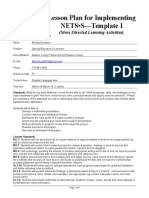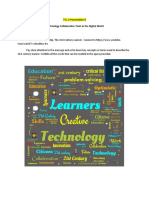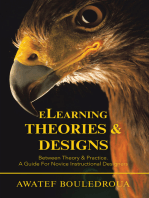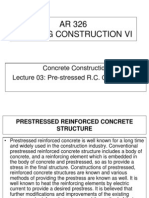Group 3 Edtech
Group 3 Edtech
Uploaded by
api-335914998Copyright:
Available Formats
Group 3 Edtech
Group 3 Edtech
Uploaded by
api-335914998Original Title
Copyright
Available Formats
Share this document
Did you find this document useful?
Is this content inappropriate?
Copyright:
Available Formats
Group 3 Edtech
Group 3 Edtech
Uploaded by
api-335914998Copyright:
Available Formats
LESSON 10
The Computer as a Tutor
The computer is one of the wonders of human ingenuity, even in
its original design in 1950s to carry out complicated mathemetical and
logical operations.They saw its potential for individualization in learning.
They therefore devised strategies to use computer to break the barriers to
individualized instruction.
Computer-assisted instruction (CAI)
The computer can be a tutor in effect relieving the teacher of
many activities in his personal role as classroom tutor. It should be made
clear that the computer cannot totally replace the teacher since the
teacher shall continue to play the role of information deliverer and
learning environment controller.
The teacher must:
Ensure that students have the needed knowledge and skills for any
computer activity.
Detcide the appropriate learning objectives.
Plan the sequential and structured activities to achieve objectives.
Evaluate the students achievements by ways of tests the specific
expected outcomes.
The students in CAI:
Receive information.
Understand the instruction for computer activity
Retain/keep in mind the information and rules for computer activity
Apply the knowledge and rules during the process of computer
learning.
The computer:
Acts as a sort of tutor
Provides a learning environment.
Delivers learning instruction.
Reinforce learning through drill-and-practice.
Provides feedback.
CAI Integrated with Lessons
CAI works best in reinforcing learning through repetitive exercises
such that students can practice basic skills or knowledge in various
subject areas. The computer is a tutor in in this new age of learning. It
does not replace the teacher, although it assumes certain roles previously
assigned to teachers who now has to take the new role of facilitator and
guide.
In integrating computer programs instruction, use tutorial software
associated with cognitive learning.
The tutorial software:
Teach new content/new information to students
Provide comprehensive information on concepts in addition to
pratice exercises.
Can be effectively used for remediation, reviewing, or enrichment.
Allow the teacher to introduce follow-up questions to stimulate
students learning.
Permits group activity for cooperative learning.
SIMULATION PROGRAMS
Simulation software materials are another kind of software that is
constructivist in nature. These simulation software:
Teaches strategies and rules applied to real-life problems/situations.
Asks students to make decision on models or scenarios.
Allows students to manipulate elements of model and get the
experience of the effects of their decisions.
INSTRUCTIONAL GAMES
Instructional computer games add the elements of competition
and challenge.GeoSafari is an example of instructional games. Learning
outcomes can be achieved along simple memorization of information,
keyboarding skills, cooperation and social interaction.
PROBLEM SOLVING SOFTWARE
These are more sophisticated than the drill and practice exercises
and allow students to learn and improve on their problem solving
ability.The students have to employ higher thinking skills such as logic,
recognition, reflection, and strategy-making.
MULTIMEDIA ENCYCLOPEDIA AND ELECTRONIC BOOKS
The Multimedia Encyclopedia can store a huge database with
texts, images, animation, audio and video. Childrens Encyclopedia is an
example of Multimedia Encyclopedia.
Electonic bokks provide textual information for reading,
supplemented by other types of multimedia information. Exampls es are
Just Grandma and Me animated storybook.
CONCLUSION
The computer is atutor in this new age of learning. It does not
replace the teacher. Also, computer activities are not the end-all of
learning since they have to conform to the lessons/curriculum. Integrating
computer is the new task of teacher.
LESSON 11
The Computer as the Teachers Tool
In this lesson, we shall again look at the computer, but this time
from another perspective the computer as the teachers handy-tool. It can
in fact support the constructivist and social constructivist paradigms of
constructivist learning.
Constructivism was introduced by Piaget (1981) and Bruner
(1990). They gave stress to knowledge discovery of new
meaning/concepts/principles in the learning process.
Social constructivism iof knowledge is an effort to show that the
construction of knowledge is governed by social, historical and cultural
contexts.
The psychologist Vygotsky stressed that learning is affected by
social influences.He suggested the interactive process in learning. Dewey
sees language as a medium for social coordination and adaption.
Learning Framework
Assumption
Definition of Learning
Learning Strategies
General Orintation
Example
Constructivism
Knowledge is
constructed by the
individual
Students build their
own learning
Gather unorganized
information to create
new concept/principle
Personal discovery of
knowledge
8*5-8+8+8+8+8
Social Constructivism
Knowledge is
constructed within a
social text
Students build
knowledge influenced
by the social context
Exchange and share
form ideas, stimulates
thinking
Students discuss and
discover meanings
Two alternative job
offers
Option 1 8 hrs./day
for 6 days/week
Option 2 9 hrs./day
for 5 days/week
The Computer Capabilities
The computer can provide access to information, foster creative
social knowledge-building, and enhance the communication of the
achieved project package. The modern computer can help teacher-andstudents to focus on more high level cognitive tasks.
Informative Tool
The computer can provide vast amounts of information in various
forms, such as texts, graphics, sound, and video. The Internet itself
provides an enormous database from which users can access global
information resources. The Internet on Education can be sourced for kinds
of educational resources on the Internet.
Constructive Tool
The computer itself can be used for manipulating information,
visualizing ones understanding, and building new knowledge. The
Microsoft Word computer program is a desktop publishing software that
allows users to organize snd present their ideas in attractive formats.
Co-constructive Tool
Students can use constructive tools to work cooperativey and
construct a shared understanding of new knowledge. The ComputerSupported International Learning Environments (CSILE) is an example of
an integrated environment developed by the Ontario Institute for Studies
in Education. Within CSILE, students can enter their ideas in notes and
respond to each others ideas.
Situating Tool
By means of virtual reality (RS) extension systems, the computer
can create 3-D images on display to give the user the feeling that are
situated in a virtual environment. An example of this is a flight stimulation
program which places the user in a stimulated flying environment.
Evaluating Web Sites: Criteria and Tools
The Primary Factor
The User Context: The most important factor when evaluating
Web sites is your search, your needs. What are you using the Web
for? Entertainment? Academic work? Hobbies or avocational
interests? Scholarly sources are traditionally very strongly textbased.Compare the appearance and the content of an academic
journal with a popular magazine.
The Web Context: Some of the visual distinctions that signal the
nature of content in print sources hold true on the Web as well,
although, because the Web encourages wider use of graphics, Web
versions of printed works usually contain more graphics and more
color than their print counterparts.
6 Criteria for Websites
1. AUTHORITY
Authority reveals that the person, institution or agency
responsible for a site has the qualifications and knowledge to
do so.
Evaluating a web site for authority:
Authorship: It should be clear who developed the site.
Contact information should be clearly provided: e-mail address, snail mail
address,
phone number, and fax number.
Credentials: the author should state qualifications, credentials, or
personal background
that gives them authority to present information.
Check to see if the site supported by an organization or a commercial
body
2. PURPOSE
The purpose of the information presented in the site should be
clear. Some sites are meant to inform, persuade, state an
opinion, entertain, or parody something or someone.
Evaluating a web site for purpose:
Does the content support the purpose of the site?
Is the information geared to a specific audience (students,
scholars, general reader)?
Is the site organized and focused?
Are the outside links appropriate for the site?
Does the site evaluate the links?
Check the domain of the site. The URL may indicate its purpose.
3. COVERAGE
It is difficult to assess the extent of coverage since depth in a
site, through the use of links, can be infinite. One author may
claim comprehensive coverage of a topic while another may
cover just one aspect of a topic.
Evaluating a web site for coverage:
Does the site claim to be selective or comprehensive?
Are the topics explored in depth?
Compare the value of the sites information compared to other
similar sites.
Do the links go to outside sites rather than its own?
Does the site provide information with no relevant outside links?
4. CURRENCY
5. Currency of the site refers to: 1) how current the information
presented is, and 2) how oftenthe site is updated or maintained. It is
important to know when a site was created, when it was last
updated, and if all of the links are current.
Evaluating a web site for currency involves finding the date information
was:
first written
placed on the web
last revised
Then ask if:
Links are up-to-date
Links provided should be reliable. Dead links or references to sites
that have moved are
not useful.
Information provided so trend related that its usefulness is limited to
a certain time
period?
the site been under construction for some time?
5. OBJECTIVITY
6. Objectivity of the site should be clear. Beware of sites that contain
bias or do not admit its bias freely. Objective sites present
information with a minimum of bias.
Evaluating a web site for objectivity:
Is the information presented with a particular bias?
Does the information try to sway the audience?
Does site advertising conflict with the content?
Is the site trying to explain, inform, persuade, or sell something?
6. ACCURACY
7. There are few standards to verify the accuracy of information on the
web. It is the responsibility of the reader to assess the information
presented.
Evaluating a web site for accuracy:
Reliability: Is the author affiliated with a known, respectable
institution?
References: do statistics and other factual information receive
proper references as to their origin?
Does the reading you have already done on the subject make the
information seem
accurate?
Is the information comparable to other sites on the same topic?
Does the text follow basic rules of grammar, spelling and
composition?
Is a bibliography or reference list included?
You might also like
- Materials Design and Current TrendsDocument3 pagesMaterials Design and Current TrendsElaine Cunanan Madula100% (4)
- Group 3 Edtech EditedDocument9 pagesGroup 3 Edtech Editedapi-335925339No ratings yet
- Et 247 Matrix 1Document11 pagesEt 247 Matrix 1api-316948987No ratings yet
- Interaction: Principles and Practice: ELI Summer Session 2005Document9 pagesInteraction: Principles and Practice: ELI Summer Session 2005donadthNo ratings yet
- Technology Integration-PortfolioDocument2 pagesTechnology Integration-Portfolioapi-402142560No ratings yet
- Lesson 11: The Computer As The Teacher's ToolDocument19 pagesLesson 11: The Computer As The Teacher's ToolArmee AganNo ratings yet
- Et 347 Eportfolio Matrix Miranda SiemensDocument9 pagesEt 347 Eportfolio Matrix Miranda Siemensapi-302040335No ratings yet
- Lesson 11: The Computer As The Teacher's ToolDocument12 pagesLesson 11: The Computer As The Teacher's ToolArmee AganNo ratings yet
- Group 3 1st ReportDocument6 pagesGroup 3 1st Reportapi-335919883No ratings yet
- Reporting TTLDocument6 pagesReporting TTLhannahezekiahlegaspiNo ratings yet
- Lesson 2Document4 pagesLesson 2Efraem CelesteNo ratings yet
- Ttl2 MidtermDocument11 pagesTtl2 MidtermSalwa CamsaNo ratings yet
- Group1 EdtechDocument8 pagesGroup1 Edtechapi-335914998No ratings yet
- Igloria F Canonigo Educ 118 Lesson OutlineDocument14 pagesIgloria F Canonigo Educ 118 Lesson Outlineapi-267898429No ratings yet
- Technology Integration Template-CollaborationDocument3 pagesTechnology Integration Template-Collaborationapi-487905844No ratings yet
- P2 Exam ReviewerDocument12 pagesP2 Exam ReviewerAlden Tagupa EscobidoNo ratings yet
- Group 3Document7 pagesGroup 3api-336172081No ratings yet
- Rationale PaperDocument23 pagesRationale PaperryanosweilerNo ratings yet
- TTL2-Prelim Exam Part 2 and 3Document9 pagesTTL2-Prelim Exam Part 2 and 3denzellvillaverNo ratings yet
- Haleys Eportfolio MatrixDocument6 pagesHaleys Eportfolio Matrixapi-322322376No ratings yet
- Lady FinalDocument4 pagesLady Finalapi-297118652No ratings yet
- Instructional Software Lesson Idea Template2022 1Document3 pagesInstructional Software Lesson Idea Template2022 1api-724036704No ratings yet
- Technology Integration Template-Collaboration 2Document2 pagesTechnology Integration Template-Collaboration 2api-369555372No ratings yet
- Educ 118Document15 pagesEduc 118api-263015414No ratings yet
- Et 347 - Mobile Learning MatrixDocument6 pagesEt 347 - Mobile Learning Matrixapi-3016846480% (1)
- Supplementary LecturesDocument13 pagesSupplementary LecturesMarc Anthony ManzanoNo ratings yet
- Instructional SoftwareDocument4 pagesInstructional Softwareapi-235491175No ratings yet
- Interactive LearningDocument5 pagesInteractive LearningFa Bi EsNo ratings yet
- Visual Media, Digital Fluency and Virtual ClassroomDocument9 pagesVisual Media, Digital Fluency and Virtual ClassroomApril Ann Estrada LimNo ratings yet
- Unit 6 Technology Based TeachingDocument30 pagesUnit 6 Technology Based TeachingerebarenzoeanneNo ratings yet
- Lesson 10 and 11Document4 pagesLesson 10 and 11api-336175968No ratings yet
- text A Virtual Learning Environment (VLE, Tracking, Collaboration and Communication ToolsDocument5 pagestext A Virtual Learning Environment (VLE, Tracking, Collaboration and Communication ToolsHanNo ratings yet
- Tel311 Dandurand Technology Integration Template - CollaborationDocument2 pagesTel311 Dandurand Technology Integration Template - Collaborationapi-380894247No ratings yet
- Et 347 - Matrix StorybirdDocument6 pagesEt 347 - Matrix Storybirdapi-301684648No ratings yet
- Outline in Educ 118Document19 pagesOutline in Educ 118api-262925714No ratings yet
- ICT in The English ClassroomDocument5 pagesICT in The English ClassroomElias CuelloNo ratings yet
- Assessment -National and Specialized Skills Training on the Fundamentals of Digital Literacy and Artificial Intelligence for EducatorsDocument3 pagesAssessment -National and Specialized Skills Training on the Fundamentals of Digital Literacy and Artificial Intelligence for Educatorskanecarpio1121No ratings yet
- RIZALUTE E-Portfolio ttl2Document15 pagesRIZALUTE E-Portfolio ttl2Rona Liee PelaezNo ratings yet
- Et 347 - Soundscape MatrixDocument10 pagesEt 347 - Soundscape Matrixapi-301684648No ratings yet
- Ed Tech PresentationDocument22 pagesEd Tech Presentationapi-556872282No ratings yet
- Guiding Principles in The Selection and Use of StrategiesDocument12 pagesGuiding Principles in The Selection and Use of StrategiesBenjamin S. CapuyanNo ratings yet
- Julias First MatrixDocument7 pagesJulias First Matrixapi-316931702No ratings yet
- Teach WellDocument13 pagesTeach WellKieth RosalNo ratings yet
- Internship Response PaperDocument18 pagesInternship Response Paperapi-548610504No ratings yet
- Ped 16Document9 pagesPed 16api-353736185No ratings yet
- Lesson Plan For Implementing NETS - S-Template I: (More Directed Learning Activities)Document7 pagesLesson Plan For Implementing NETS - S-Template I: (More Directed Learning Activities)api-534480371No ratings yet
- Tech Integration Matrix - Google Trek-2Document8 pagesTech Integration Matrix - Google Trek-2api-302040335No ratings yet
- Ict PresentationDocument22 pagesIct PresentationairamNo ratings yet
- Technology Integration Form - COLLABORATION: General InformationDocument3 pagesTechnology Integration Form - COLLABORATION: General Informationapi-402142560No ratings yet
- Et 347 Storybird MatrixDocument6 pagesEt 347 Storybird Matrixapi-316927427No ratings yet
- Student Name: Jean Kang Date: 6/12/2020 Artifact Description: Web LaunchpadDocument4 pagesStudent Name: Jean Kang Date: 6/12/2020 Artifact Description: Web Launchpadapi-516574894No ratings yet
- Lesson Plan For Implementing NETS - S-Template I: (More Directed Learning Activities)Document5 pagesLesson Plan For Implementing NETS - S-Template I: (More Directed Learning Activities)api-290638407No ratings yet
- Lesson 16Document7 pagesLesson 16Genesis AbrasaldoNo ratings yet
- Technology Integration Template-Collaboration 2Document2 pagesTechnology Integration Template-Collaboration 2api-383723476No ratings yet
- Tech Integration Matrix 1Document7 pagesTech Integration Matrix 1api-307498864No ratings yet
- Discussion QuestionsDocument4 pagesDiscussion QuestionsteobigmatNo ratings yet
- TTL 1 Presentat-WPS OfficeDocument9 pagesTTL 1 Presentat-WPS OfficeArlyn Dellica100% (1)
- Technology Integration CollaborationDocument2 pagesTechnology Integration Collaborationapi-381447326No ratings yet
- I. Computer Technology and Learning: Role of The StudentDocument6 pagesI. Computer Technology and Learning: Role of The Studentchocoholic potchiNo ratings yet
- Elearning Theories & Designs: Between Theory & Practice. a Guide for Novice Instructional DesignersFrom EverandElearning Theories & Designs: Between Theory & Practice. a Guide for Novice Instructional DesignersNo ratings yet
- Hệ Thống SemanticsDocument3 pagesHệ Thống Semanticsms.phiyen.1988No ratings yet
- Pressure Seal Bonnet Valve Maintenance GuideDocument76 pagesPressure Seal Bonnet Valve Maintenance GuideAgustin A.No ratings yet
- ScriptDocument4 pagesScriptTrương KhánhNo ratings yet
- Ion Cleanse Info PKGDocument10 pagesIon Cleanse Info PKGthewishingwellNo ratings yet
- 20-22 - Management of Patients With Dermatologic DisordersDocument113 pages20-22 - Management of Patients With Dermatologic DisordersTaif Salim100% (1)
- Maxima and Minima ProblemsDocument44 pagesMaxima and Minima ProblemsMeggy Villanueva100% (2)
- LG 47le8500 Training Manual PDFDocument93 pagesLG 47le8500 Training Manual PDFHorváth KrisztiánNo ratings yet
- Oil and Gas AcronymsDocument44 pagesOil and Gas AcronymsStanley EkechukwuNo ratings yet
- Fry Sight Word ListDocument6 pagesFry Sight Word ListAniket MahulikarNo ratings yet
- Unit 1 (EDUC 5410) WADocument6 pagesUnit 1 (EDUC 5410) WAFRANCISCO ANTONIO DE LEON100% (1)
- Specifications and RequirementsDocument22 pagesSpecifications and RequirementsMohammed AnasNo ratings yet
- Hemodynamic PathologyDocument9 pagesHemodynamic PathologyjoeNo ratings yet
- Edexcel IAL P2 Chapter Review 2 (Solution)Document19 pagesEdexcel IAL P2 Chapter Review 2 (Solution)Kaif HasanNo ratings yet
- Prepositions in DiscourseDocument42 pagesPrepositions in DiscourseClarissa AyresNo ratings yet
- Christopher Daza Resume:CVDocument2 pagesChristopher Daza Resume:CVchris dazaNo ratings yet
- By-Prateek Bebortha Regn No-1727524 Class-1MBA-HDocument18 pagesBy-Prateek Bebortha Regn No-1727524 Class-1MBA-Hprateek beborthaNo ratings yet
- Project Document TemplateDocument5 pagesProject Document TemplateMUHAMMAD IRFANNo ratings yet
- MehotrassDocument26 pagesMehotrassshiwani sharmaNo ratings yet
- School of SpectraDocument4 pagesSchool of SpectraSenhorDosVermesNo ratings yet
- Yawa Nga Tigulang BogokDocument4 pagesYawa Nga Tigulang BogokJoshua Matthew Romylle ManzanoNo ratings yet
- Lecture 03Document28 pagesLecture 03Isaac ShinyelaNo ratings yet
- Business Case Review of Leslie Brinkman and Versutia CapitalDocument9 pagesBusiness Case Review of Leslie Brinkman and Versutia Capitalraju razNo ratings yet
- Wind Loading of Porous Fabric Roofs - THE15828Document312 pagesWind Loading of Porous Fabric Roofs - THE15828Steve HuppertNo ratings yet
- Wired and Wireless MediaDocument4 pagesWired and Wireless MediaSadia AwanNo ratings yet
- Cambridge English Empower Empower B1 Reading Plus Teacher U04 WorksheetDocument1 pageCambridge English Empower Empower B1 Reading Plus Teacher U04 WorksheetSara AljoozNo ratings yet
- Microsoft Word - HRM 2Document10 pagesMicrosoft Word - HRM 2sanakalpa avtNo ratings yet
- Patient Scenario, Chapter 17, Nursing Care of A Postpartal FamilyDocument8 pagesPatient Scenario, Chapter 17, Nursing Care of A Postpartal FamilyAngel Lynn Ylaya100% (3)
- I. MULTIPLE CHOICE: Choose The Letter of The Correct Answer. Use The Answer Sheet ProvidedDocument2 pagesI. MULTIPLE CHOICE: Choose The Letter of The Correct Answer. Use The Answer Sheet ProvidedayensantosNo ratings yet
- Report On Visit To Maddhapara Granite Mine & Boropukuria Coal MineDocument28 pagesReport On Visit To Maddhapara Granite Mine & Boropukuria Coal MineMd Faisal Karim100% (1)
- Acids and Bases Part 4 (Titration Curves) EdexcelDocument5 pagesAcids and Bases Part 4 (Titration Curves) EdexcelKevin The Chemistry Tutor50% (2)


